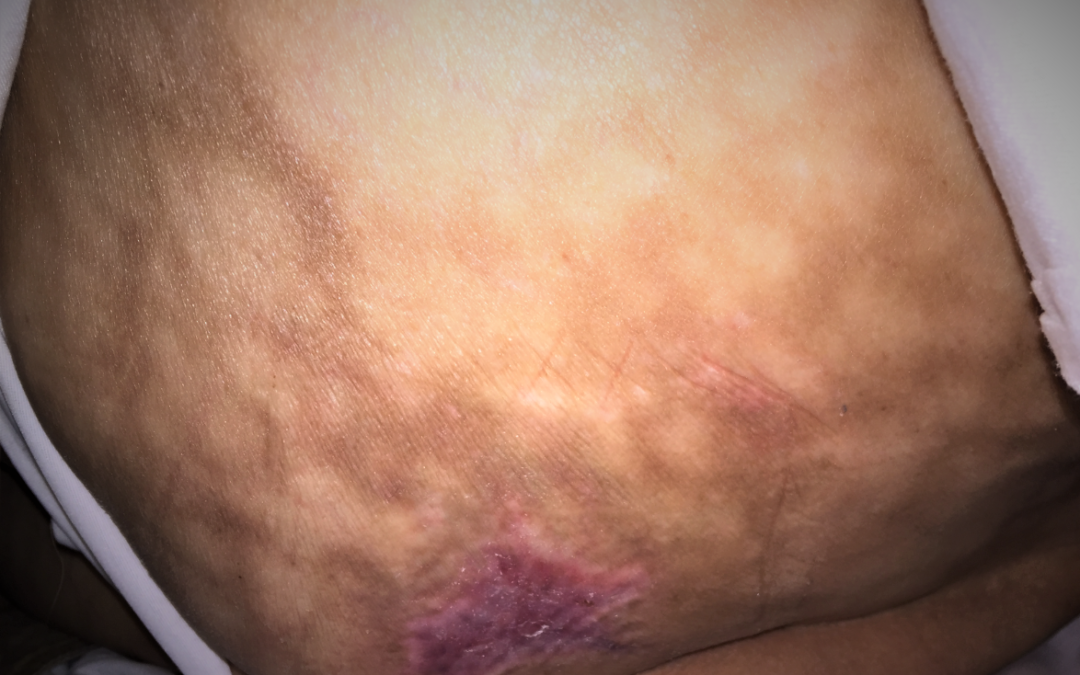Here are two patients with “livedoid” skin changes. Are they the same thing?
Case #1: A 66 year old woman with a narcotic addition who fell asleep on her heating pad and suffered a burn on her buttock (see above). She has livedoid changes to the skin – a reticulated (fishnet-like) pattern of hyperpigmentation. The skin changes are not painful. What is it?
She has Erythema ab igne. The Latin name can be translated as “redness from fire.” Erythema ab igne is a skin reaction caused by chronic exposure to infrared radiation in the form of heat. The lace-like pattern is caused by repeated, heat-related injury to superficial vascular networks. It’s uncommon now, but a generation or two ago, it was a common occupational hazard for people working near open fires such as bakers and metalworkers, and among elderly people who sat too close to open fires or space heaters. Central heating and other technological advances have made this condition relatively rare, but it’s on the rise again on the anterior thighs. Why? You guessed it! Laptop computer batteries. Also implicated nowadays are heated car seats, hot water bottles and heating pads. It’s a warning for those of us who have reached the “chihuahua” stage of life – shivering all the time. (I use my heated car seats a lot.) The lesions are usually asymptomatic.
In the case of this woman, who was sleepy and slurred her words during the consultation, the presence of Erythema ab igne in the setting of a burn suggest that she regularly sleeps on a heating pad and is unable to awaken in response to pain. She’s not safe at home. If there is no family to intervene and hospitalization is not an option, it may be appropriate to inform Adult Protective Services.

Case #2: A 66 year old man with excruciatingly painful, bilateral lower leg ulcerations which began after minor trauma. His problem has been going on for months. He has seen multiple physicians and carries the presumptive diagnosis of pyoderma gangrenosum, but he’s got ischemic pain in this leg. His expanding ulcerations have kept him from noticing the visible skin changes, but he has noticed excruciating calf pain. What is it?
 He has the physical finding of Livedo reticularis (LR), characterized by a reddish-blue or purple, net-like, cyanotic pattern on the skin. LR is the manifestation of a cutaneous blood flow disturbance that can be associated with many potentially serious conditions, including systemic lupus erythematosus, dermatomyositis, clotting disorders like Thrombophilia, and vasculitis. His history made me really suspicious for vasculitis. He was hospitalized, but I couldn’t convince the hospitalist to obtain a wedge biopsy of the skin changes on the calf, because everyone was focused on the ulcerations. The calf lesions rapidly progressed (Case 2.b) even during his hospitalization. It took several weeks an a lot of consultations with dermatology and rheumatology at the Houston Medical Center to determine that he has polyarteritis nodosa (PAN). I will talk about his case a lot more in the future. Eventually nearly the entire posterior calf became necrotic. This is one of those times that the very large, open wounds were not the physical finding to focus on.
He has the physical finding of Livedo reticularis (LR), characterized by a reddish-blue or purple, net-like, cyanotic pattern on the skin. LR is the manifestation of a cutaneous blood flow disturbance that can be associated with many potentially serious conditions, including systemic lupus erythematosus, dermatomyositis, clotting disorders like Thrombophilia, and vasculitis. His history made me really suspicious for vasculitis. He was hospitalized, but I couldn’t convince the hospitalist to obtain a wedge biopsy of the skin changes on the calf, because everyone was focused on the ulcerations. The calf lesions rapidly progressed (Case 2.b) even during his hospitalization. It took several weeks an a lot of consultations with dermatology and rheumatology at the Houston Medical Center to determine that he has polyarteritis nodosa (PAN). I will talk about his case a lot more in the future. Eventually nearly the entire posterior calf became necrotic. This is one of those times that the very large, open wounds were not the physical finding to focus on.

Dr. Fife is a world renowned wound care physician dedicated to improving patient outcomes through quality driven care. Please visit my blog at CarolineFifeMD.com and my Youtube channel at https://www.youtube.com/c/carolinefifemd/videos
The opinions, comments, and content expressed or implied in my statements are solely my own and do not necessarily reflect the position or views of Intellicure or any of the boards on which I serve.



